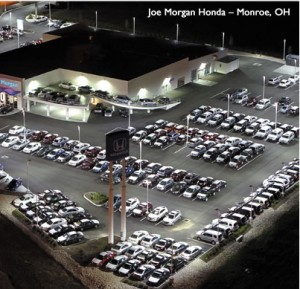
Joe Morgan Honda using LED Car Dealer Lighting
You can see it from a mile away: the stretch of American highway where one car dealership after another is uber-illuminated: one seemingly trying to outshine the other. Unfortunately, much of this car dealer lighting is spilling off the lots’ perimeters, as well as being wasted upward into the night sky. While these lights serve a dual purpose of attracting potential customers and as a 24/7 security system, they devour energy.
An environmentally conscious car dealership seems a contradiction in terms. In lighting circles, car dealerships are often the bogeyman: arch enemy of conservationists and dark-skies advocates. However, the bottom line rules: by living and working sustainably, dealerships can reduce costs, increase their brand recognition, and attract more customers.
Including this extensive use of lighting, auto dealerships consume on average more energy per square foot than a typical office building: using about 110 kBTU/sqft compared to prime office space at 93 kBTU (source: National Automobile Dealers Association). This can mean thousands of dollars in energy costs for the typical dealership each year.
According to E Source, energy is the third-highest overhead expenditure for dealership, so reducing electricity consumption is a major consideration. In 2006, the National Automobile Dealers Association (NADA) formally endorsed the US Environmental Protection Agency’s Energy Star Challenge, asking their 20,000 members to reduce energy use by 10 percent or more annually. The EPA estimates that if auto dealers cut their energy use by 10 percent (annually), they would save nearly $193 million and prevent more than 1 million tons of greenhouse gas emissions.
In 2007, NADA and Energy Star launched a joint Energy Stewardship Initiative to help auto dealers improve the energy efficiency of their facilities and operations. The initiative provides data, tools, and other strategies for dealers to implement improved energy practices and technologies. Since its launch, more than 800 dealerships have improved the efficiency of their facilities by reducing energy use by 10 percent or more annually.
Automakers have been marketing efficient products for years, with low-emission, high-mileage vehicles that appeal customers looking to save fuel and to buyers eager to own a “green” vehicle. Now dealerships are taking up the banner. Renovations such as LED lighting retrofits or the installation of LED luminaires during new construction are an excellent way for car dealerships to begin achieving their sustainability objectives.
Car Dealer Lighting at Joe Morgan Honda
Honda, for instance, promotes its 40 years of environmental leadership. So when the Joe Morgan Honda automobile dealership in Monroe, OH, began design development, the owners, architect, and builder knew they needed to emphasize sustainability.
At first the design team considered traditional metal halide fixtures to illuminate the 350 car inventory, but wanted to learn more about exterior LED luminaires. After seeing state-of-the-art products and learning about the energy savings – 60 percent over metal halide – it was an easy decision.
The dealership installed 59 BetaLED THE EDGE area luminaires with various optics, and expects a 3 year ROI. The LED luminaires provide continuous light levels for the entire parking lot, reduced hazardous waste disposal, and dramatic electrical efficiency. Additionally, these luminaires are virtually maintenance free, further reducing overhead.
“The BetaLED exterior lighting allows us to drive down operating expenses, present our cars in the best light, and contribute to the greening of our community,” said Dick Lange, Joe Morgan Honda general manager.
Both employees and customers have noticed the bright, white lights. Customers typically comment about how much easier it is to see the cars, anywhere in the lot. And knowing that Joe Morgan Honda is the first car dealership in Ohio with LED luminaires, the sales associates specifically point out the LED lights and mention the dealership’s philosophy of helping lead the industry into a greener automotive future.
“We installed the LED luminaires, along with many other sustainable products because it pays back in so many ways; and it’s the right thing to do,” added Lange.
Other Sustainability Initiatives
Manufacturers’ national initiatives, consumers increased concerns about environmental issues, and the challenging economy have forced dealers across the US to reduce their operations costs.
In 2008, a state-of-the-art General Motors dealership in Michigan applied for LEED Gold certification, two months after a Texas Toyota dealership became the first in the US to achieve the distinction.
In 2010, Ford introduced a pilot program, Go Green Initiative, at three of its dealerships and is planning to make changes at all 3500 dealerships nationwide. The three dealerships – in Florida, New York and Nevada – implemented a comprehensive assessment and evaluation of the firms’ impacts, primarily from an energy-use standpoint. Lighting was a key element of the retrofits, aimed at addressing both the quantity and the quality of the on-site lights, and providing one of the quickest paybacks.
There are both state incentives and federal tax credits available to help offset lighting retrofits. For example, New Jersey has been offering $100-$200 for every fixture (400w-1000w) changed out or retrofitted; meaning, if a dealership changes 50 pole lights it will qualify for $5,000-$10,000 in state incentives.
There are also US federal tax credits available through the Energy Efficient Commercial Buildings Tax Deduction (CBTD) and bonus depreciation. The CBTD allows a business that has installed or retrofitted the interior space with energy-efficient lighting, while still meeting acceptable light levels, to earn an accelerated tax credit of up 60 cents per sqft.
For an exterior retrofit such as pole lighting, the dealer may use the bonus depreciation deduction, which allows the owner or leaseholder to deduct 100 percent of the equipment purchased in the year it was put in service, rather than the typical 39 year straight depreciation. This bonus depreciation is scheduled to expire: after 2011 the deduction amount will only be 50 percent.
Written by Chris Cullen
A version of this article originally appeared in the BetaLED Newsletter. Chris Cullen is a regional sales manager with BetaLED.